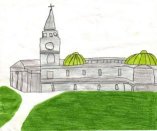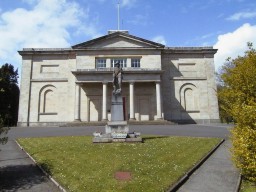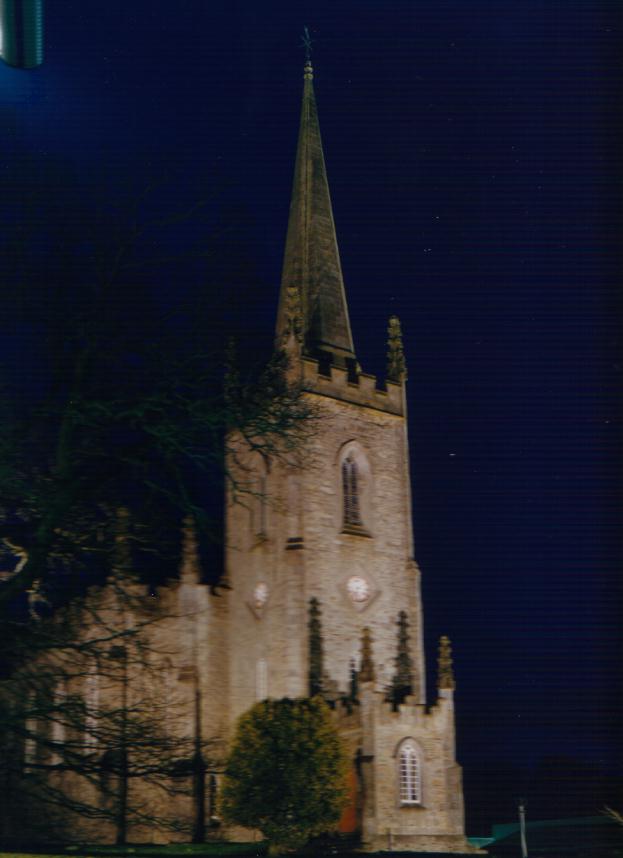 
|
The
Cathedral of Saint Felim and Saint Patrick:
The Cathedral of Saint Felim and Saint Patrick located on Farnham Street was built
in the 1900's. The architect was Ralph Byrne. Work
started in 1939,
but the Cathedral was
not consecrated until 1947 because the work was delayed by the second
world war. It is built
of granite with limestone and Portland stone details. It
has five bays and is two storeys high. The spire stands
224 ft above Farnham Street and is topped with a gilded
cross. The
First Catholic Church was built in 1823 on the same site,
the land was supplied by the fourth Baron Farnham. In
1843 Bishop James Brown of Kilmore moved the seat of
bishopric from Cootehill to Cavan. Then in 1862
renovation was carried out to Cavan church and it was
raised to the status of a Cathedral.In the later part of
the 19th century it had some of the finest church
furniture. Pews were reserved for some of Cavan's more
important citizens. In 1919 a decision was made to build
a bigger cathedral on the site behind the old cathedral.
The old Cathedral was taken down stone by stone and
rebuilt in Ballyhaise.
|
 |
The
Courthouse situated on Farnham Street dates
from 1824,at the cost of £11,000 to £12000 pounds and
owes its existence to the Farnham Estate. It was built by
Mssr Colbourne and Williams of Dublin and was built from
sandstone taken from the local quarry at Latt.The facade
has five bays and is two storey. In 1987 the Courthouse
was practically and reconstructed by Mssrs.P.Elliott
& Co. The Statue in front of the Courthouse
commemorates Thomas Ashe one of the volunteers of the
1916 rising. In addition to court sittings the building
is now the seat of the County Council and the Urban
District Council which administers local government in
the county. The County Manager is Mr. Brian Johnston.
Find out more about the Council by clicking on this link
http://www.cavanudc.ie
|
 |
Cavan
Church of Ireland belongs to the Parish of
Urney.This church dates from the early 1800's. It opened
for worship in 1815. It was designed by John Bowden. It
is built of sandstone. The church has an octagonal spire
and a three faced clock. The church is surrounded by a
sandstone wall.One of the monuments on view is a
sculpting dedicated to the Earl of Farnham and signed
"Chantry London 1826". The present rector is
Canon Mark Lidwill. Views of Cavan Church.
Find out more about the
Diocese of Kilmore @ http://www.ireland.anglican.org/dioceses/kilmore/kilmore.html
|
 |
The
Presbyterian Church is a single cell
building with a porch at the west end. It has six
pinnacles, three on the porch and three on the gable end.
It is inscribed 'Scots Church 1836' and built of large
blocks of sandstone. The first rector was Rev. Robert
Fleming. The present minister is Rev. Jean Mackarel. She
was installed as minister in the congregations of Cavan,
Killeshandra, Drumkeeran and Bellasis on 27th January
1986. |
 |
The
Methodist Church is situated on Farnham
Street. It was built in 1874. It is built of limestone.
It is a single cell with a pointed west window The tower
which was never completed contains the pointed doorcase.The
church closed in the early 1970's and is now Abbey
Printers. |
| Cana
House:is situated on Farnham Street behind
St. Felim's Boys School on the site of the old Gaol.In
early 1988, Cavan County Council in conjunction with Fás
training centre, Dundalk, Co.Louth set-up a project to
index the parish registers of baptisms, marriages and
burials. The local historical society was also involved
at that stage and the committee to oversee the project
was called Cumann Seanchais Bhreifne Genealogical Sub-committee.
Over the years the project expanded and continued to
computerise and index not just church records but census
records, land records and various other sources of a
genealogical nature. Similar centres were found all over
Ireland North and South and the All Ireland project came
to be known as the Irish Genealogical Project (IGP). The
sub-committee was abolished in 1994 and replaced by a
limited company with a board of directors. Find out more
about @ http://www.mayo-ireland.ie/Geneal/Cavan.htm or http://www.irishroots.net/Cavan.htm
|






